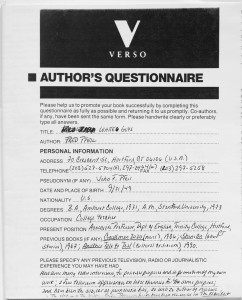[Posted as 9 of 10 in a series on the College Archives by Emma Paine, a graduate student intern from Simmons College]
 “Please don’t send sticky envelopes to the tropics!” the note read, followed with a kindly reminder “US stamp no good here.” The hastily handwritten scrawl on the bottom of the nearly empty alumni survey immediately caught my attention. “Where is this man?” I thought as I began to look through the file, “And what is he doing there?”
“Please don’t send sticky envelopes to the tropics!” the note read, followed with a kindly reminder “US stamp no good here.” The hastily handwritten scrawl on the bottom of the nearly empty alumni survey immediately caught my attention. “Where is this man?” I thought as I began to look through the file, “And what is he doing there?”
 According to the ink stamp on the document, Trinity received this message in November 1958, just as its author, the Rev. Jack Townsend, was wrapping up his eleventh year as Executive Secretary of the Missionary District of the Panama Canal Zone and Archdeacon for the Republic of Colombia. By November, Rev. Townsend would also have been preparing for a two-month trip to the fairly new missionary territory of Ecuador, where he was one of the first Episcopal clergymen chosen “to provide ministrations of the Words and Sacraments, until [the Bishop Gooden] could go himself and later provide resident priests.” There are two accounts of this trip in his Alumni File, describing his first view of “the headlands from which Balboa (not stout Cortes) first saw the Pacific Ocean,” a baptism conducted in English and Spanish (“the first time in their lives they heard a baptism conducted in their own language”), and a flight to Quito, Peru through the High Andes (“There was not a sign of life as we threaded our way back and forth. It was like flying on the moon!”).
According to the ink stamp on the document, Trinity received this message in November 1958, just as its author, the Rev. Jack Townsend, was wrapping up his eleventh year as Executive Secretary of the Missionary District of the Panama Canal Zone and Archdeacon for the Republic of Colombia. By November, Rev. Townsend would also have been preparing for a two-month trip to the fairly new missionary territory of Ecuador, where he was one of the first Episcopal clergymen chosen “to provide ministrations of the Words and Sacraments, until [the Bishop Gooden] could go himself and later provide resident priests.” There are two accounts of this trip in his Alumni File, describing his first view of “the headlands from which Balboa (not stout Cortes) first saw the Pacific Ocean,” a baptism conducted in English and Spanish (“the first time in their lives they heard a baptism conducted in their own language”), and a flight to Quito, Peru through the High Andes (“There was not a sign of life as we threaded our way back and forth. It was like flying on the moon!”).
 The Rev. Townsend graduated from Trinity in 1916 and then spent three years in France as part of the Ambulance Corps for the French and American Red Cross during World War I. Four years after returning to America to finish his education at Berkeley Divinity School, he left the country again, this time to begin his lifelong career as a missionary in Latin America. In addition to his posts in Panama and Ecuador, he also served in Guantanamo and Camagüey Cuba, where he saw the beginnings of the Cuban Revolution in the 1930’s and reported them in a mailing titled “¡Hola, Amigos de Cuba!” “Many friends of Cuba will be wondering what is happening down here,” he begins, “I only wish I knew! We are cut off from real news by censors and by the extraordinary rumors circulating about, most of them false. Perhaps if I tell what I have seen it will help.”
The Rev. Townsend graduated from Trinity in 1916 and then spent three years in France as part of the Ambulance Corps for the French and American Red Cross during World War I. Four years after returning to America to finish his education at Berkeley Divinity School, he left the country again, this time to begin his lifelong career as a missionary in Latin America. In addition to his posts in Panama and Ecuador, he also served in Guantanamo and Camagüey Cuba, where he saw the beginnings of the Cuban Revolution in the 1930’s and reported them in a mailing titled “¡Hola, Amigos de Cuba!” “Many friends of Cuba will be wondering what is happening down here,” he begins, “I only wish I knew! We are cut off from real news by censors and by the extraordinary rumors circulating about, most of them false. Perhaps if I tell what I have seen it will help.”
If you want to know what he saw, stop by the Watkinson and ask for the file!





























